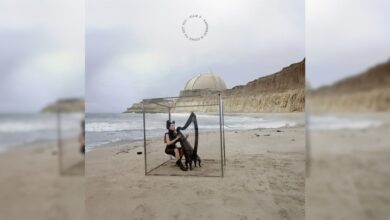‘Arrival’ takes the fiction out of science fiction
 Supplied
SuppliedArrival
Directed by Denis Villeneuve
Starring Amy Adams, Jeremy Renner, Forrest Whitaker
In theatres now
With visuals that draw you in, and content to make you stay, Arrival beautifully depicts academic research in the face of first contact.
Arrival, based on the short story “Story of Your Life” by Ted Chiang, was released in theatres November 11th. The film portrays the arrival of seven-legged extraterrestrial beings (named heptapods), who have docked ships at 12 locations around the globe, and humanity’s response to the aliens. Louise Banks (Amy Adams), a linguist and professor, is recruited by US Army Colonel Weber (Forrest Whitaker) to determine the aliens’ purpose on Earth. As Louise becomes fully immersed in the task of communicating with these beings, the film confronts us with the idea of whether language influences thought. Whether you’re experiencing academic research or simply love good science fiction, this a film, and it’s themes about identity and language, is one worth watching.
The aesthetics of Arrival are fantastic. Unlike many blockbuster sci-fi films, this one does not rely on flashy technology to drive home the premise. Director Denis Villeneuve (Sicario, Prisoners) employs visual foreshadowing, and each shot feels calculated, precise, and deeply intimate. In one instance, as we watch Louise’s interaction with the heptapods, her headset lines up with their circular language in the background. Beyond any analysis we might do, as a viewer this careful, minute detail has the ability to blow you away. On top of these visuals is the incredible score by Johann Johannsson and the aliens’ spoken language developed by Morgan Sandregor, both of which create an unsettling and ethereal atmosphere.
Throughout the film we also see a more accurate process of research than often portrayed in Hollywood. Often, films treat professors and academics as objective voices in white coats used only to justify bad science. Jessica Coon, an associate professor at McGill University who provided linguistic consulting for this film, thinks, “the movie does really well in illustrating some important parts of the fieldwork process.” An example of this occurs when Colonel Weber pressures Louise to speed up the analysis of the heptapods’ sounds and written language. She explains to him just how complex asking one question can be when confronted with a language barrier — her careful dissection of what, at first, seems like a simple question is riveting, while still based in realistic practice. Research is not shown to be a magical answer to the government’s question, but a long, exhausting process.
A key component to the plot (and my favourite part) was the film’s look at the Sapir-Whorf hypothesis, which Coon sums up as “linguistic relativity, the idea that the language you speak determines or constrains your perception of the world.” For strong linguistic relativism, this could suggest a fundamental difference in perspective, where ‘straight-forward’ languages might produce ‘straight-forward worldviews.’ For weak linguistic relativism, this is about the words or labels we use, such as the extent to which gendered language creates stereotypes of authors or objects. Arrival executes this theory beautifully, by weaving an explanation into the narrative as well as an exposition by Louise. As something that might be integral to our conception of our senses, and which seems to divide researchers, it seems that only the appearance of aliens can really give us a way to study this objectively.
All-in-all this film comes across as a labour of love. Arrival depicts what I love about science fiction: the ability to explore ideas through the use of art. Whether you spend your days in a white lab coat or not, just go see it.




